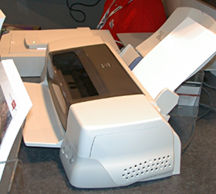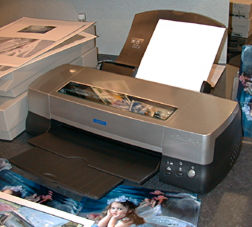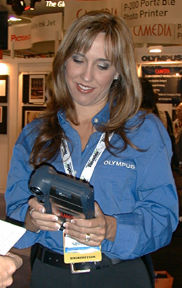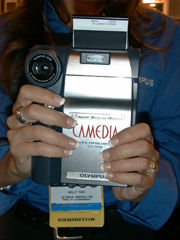| The Seybold SF 2000 report | |
SEYBOLD SAN FRANCISCO
The Show Goes On

By MIKE PASINI
SAN FRANCISCO -- If we were worried about rain yesterday, we got an even bigger scare today (see right). Among the things we were looking forward to reviewing today, that wasn't one.
Editor
Imaging Resource Digital Photography NewsletterWe were hoping to take a closer look at some inkjets and two new cameras -- and we did. But we also found some fascinating software.

The Inkjets
Seybold is geared to the professional graphics market, so we expected to see a lot more of the huge 12-cartridge inkjets than the table-top photo printers.
Still, Epson had their Stylus Photo 1270 (pictured at left), Stylus Photo 2000P (below) and the $2,995 Stylus Pro 5000 on display. And Canon was showing off their BJC-8200. The resolution of these things is, well, scary.
At $499 the Stylus Photo 1270 offers six-cartridge printing (in which a light magenta and a light cyan complement the usual CMYK arrangement, or CcMmYK) at 1440 x 720 resolution.
The Stylus Photo 2000P retails for $899 with archival ink in its six cartridges running at 1440 x 720 resolution. The ink formulation is quite a bit different from other inkjets (in fact, I'm not sure you can call the 2000P an inkjet).

It's ink pigments, uniformly sized and coated with resin, are small enough to shoot through the print head almost dry. When they hit the paper, they stick and the resin forms a protective (and waterproof) coating on top. And, since the pigment is relatively dry to start with, the newly-printed piece can be handled almost immediately.
The printer can use sheets up to 13 x 19 inches or rolls available in 4-inch, 8-inch and 13-inch widths from Epson.
The Canon BJC-8200 with 1200 x 1200 dpi claims it is 40 percent more higher than the 1400 x 720 Epsons. It isn't an obvious 40 percent, at least to my eyes. It too sported six color cartridges. But only a $299 price tag. And it offers an interesting color scanner cartridge that turns the printer into a scanner.

All of these printers made stunning prints (skin pores and wrinkles with the usual brilliantly colored accessories) right before our eyes. But we were amused to note how popular the Epson Stylus line was in other booths. High praise.
ICC PROFILE MANAGEMENT
We say an interesting analysis of how Epson's driver processes color at the Chromix booth where Steve Upton was demonstrating a suite of eight color management tools for the Mac OS called ColorThink.
The Profile Manager looks like ATM, and on the face of it does for International Color Consortium profiles (designed to document the color characteristics of input and output devices) what ATM does for fonts, grouping them in sets you can activate and deactivate at will. Like fonts, a profile file name may not be what it calls itself. But the Profile Manager lets you view them by either their external file name or their internal (full) name.
The Profile Inspector lets you view profiles graphically while the Profile Doctor performs 16 comprehensive tests on profiles and the system. And fixes them. At the very least it will move a dysfunctional profile to the desktop (as much of a fix as possible, Upton pointed out).
A Profile Renamer to change internal and external profile names, a Profile Linker to build ICC-compliant device link profiles from a source and destination profile, an Image Inspector to manage profiles embedded in images and 2D and 3D graphing of profiles and color lists round out the toolset.
We asked Upton what the documentation looks like. He's working on it, he promised, with an eye toward explaining what you can do with the product, rather than assuming the user knows the game and just wants to step up to the plate.
Then he showed us a couple of interesting things he'd been working on. Does the color gamut shift on an inkjet print as it dries? Yep. He profiled the output at 30 minutes and again at 60 minutes and graphed the difference -- in 3D -- so you could see the color space drop.
What effect does a polarizing filter have on highlights and shadows? Does it make any difference? Yep. The highlights get a little darker, but the long tails in the 3D graph of the shadows showed they get a lot darker.
And about that Epson. Turns out the Epson driver relies heavily on black, limiting the printable gamut (but don't be alarmed, it's a common technique in offset printing).
Shipping around the middle of September, Upton will be selling the product directly from the Web site at an introductory price of $99 (list $129). It requires at least Mac OS 8.5.1 and ColorSync 2.6.1.
Meanwhile try Upton's free GamutView to visualize your printer's gamut.
Cameras
We took a look at several new cameras at the show. Nikon introduced the Coolpix 880, destined to be described as "adorable" at a Web site near you, we bet, but with a few fascinating and features. And Olympus was showing off the Camedia C-211 (which spits out Polaroid prints from the camera itself).
NIKON 880
Priced at $799 the Coolpix 880 is a chunky little (but more little than chunky) camera with a 2.5x zoom (covering the 35mm equivalent of a 38-95mm range) for its 3.34 megapixel CCD (read the full review by Dave Etchells).

It's top-deck dials reminded us of the Kodak 4800. There seems to be a design shift away from the menu back to mechanical dials. Not a bad idea for frequently accessed options like the EV settings on the Kodak.
There were two things we distinctly did not like about it. First, it uses a lithium-ion (read proprietary) battery, not AAs. Which would be fine if you never needed a second battery. Second, it has no external flash. But these may only be quibbles at your kitchen table.
We did very much like one feature becoming more and more popular. Quick Review is a button just above the LCD monitor. When your subject dashes up to you just after the flash fires and begs to see how the picture came out, you don't have to flip out of record mode into play mode and wait for the LCD to come up again. You just press the Quick Review button and your last shot is displayed in the upper left corner of the LCD. You can go full screen with a second click and (using the controller) even scroll back to earlier shots. Pure genius. (Whoever thought up modes in the first place is not getting the Nobel Prize, BTW.)
Another truly fabulous feature (I'm not buying, remember) is the Best Shot Selector. Turn it on and the camera will motordrive through 10 shots and pick the sharpest. Great for low-light situations off the tripod (like trade shows).
Nikon pushed yet another feature we didn't find very exciting called Scene Mode. That's 11 preprogrammed modes to set focus, exposure and white balance (among others) for common shots: portraits, indoor parties, night portraits, beach or snow, landscapes, sunsets, night landscapes, fireworks (this is killing me), close ups, text copying (or whiteboards) and backlit scenes. Pretty soon you won't need experts anymore.
More likely the choices are confusing enough for the amateur that needs them (should that luau be shot in landscape or sunset or beach mode?). Hey, a new career choice.
It does accept the Coolpix fisheye, wide-angle converter, 2x and 3x tele converter lenses as well as a slide/film copying adapter and a remote. Just don't look for batteries at the 24-hour convenience store.
OLYMPUS & POLAROID
Maybe we're crazy but we think the Polaroid iZone is a lot of fun. We even like the small pictures. But even crazier than us, we have to admit, was the guy who crossbred an Olympus digicam with a Polaroid.
But it makes sense. You can decide if you want to print the picture or not. And you can even make copies of the picture (at last at last!). But when is a Polaroid no longer a Polaroid?
Better to think of this as a digital printing camera (does that make it a digipricam or digingcam?). Which is what Olympus calls the Camedia C-211 Zoom.

Olympus let Kelly Rae loose on the floor with one and she shot everybody in sight. I asked her how hard it was to use. "Not hard at all," she said. So I asked her what the reception was like. "Reception?" Yeah, how are people reacting to it? "Oh, they love it!" Good answer. I should have realized that with no antenna, it doesn't get any reception.

It isn't exactly small but the 2.1 megapixel CCD with a 3x optical zoom lens has to have some bulk to print on Polaroid type 500 film (15 seconds a print after you press the big blue button). A 2-1/8 by 2-7/8 image (which is being ejected out the top in the picture to the right). The specs say you can shoot a 15 second QuickTime movie, but we didn't see a VCR in the thing, either.
Not only that but it takes terrible pictures, judging by the one Rae took of us. We looked 10 or 15 years older than we really are, with far more wrinkles and pretty shabbily dressed for a stylish rake. Don't even ask about the red eye.
Something Special
When we saw our find of the show, we just stood and stared. It was so simple, so well implemented and so thorough we don't think there will ever be a version 2.0. And the problem it solves is so universal we think everyone will want it. In fact, everyone who saw the demonstration (while we were there) bought it.
It's Andromeda Software's new Photoshop plug-in (already reviewed at A-Digital-Eye; we hope to give it a spin shortly ourselves) called LensDoc. It does nothing but correct distortions you usually need a view camera to avoid. Barrel distortion (where tall columns curve inwards), perspective distortion (where vertical lines converge) and rotation (where you just didn't get things quite square).
Select the plug-in with an image open and a set of points are displayed on the screen. To correct barrel distortion three green points and three yellow points are displayed. You drag one of the green points to the end point of one curvature and one to the other end and one to the midpoint (or so). Do the same with the yellow points on the other side of the image. And presto the image is straightened out.
Perspective distortion only needs two points (for the end points) for each set. Edges are repeated or not. Your choice.
An expert mode gives you a pair of sliders to fine tune the effect.
But the deal closer was the database of film and digicam lenses that ships with the product. You can use a generic lens correction, find your lens in the database or create your own lens correction curve (the manual explains how).
We liked it so much we asked LouAnn Barbeau, the product manager, if she'd extend the show price to our readers. If you call (800) 547-0055 before Sept. 16 you can get LensDoc for $69, which is $20 off.
We may have a distorted view, but we think this will fix it.
The Show Goes On
The expo continues through tomorrow with a short day but this is our last report. Don't miss yesterday's coverage, including a few more show specials for our readers. And remember, you can keep up with us every week by subscribing to the newsletter.
Now if we can just get home before it rains.....
